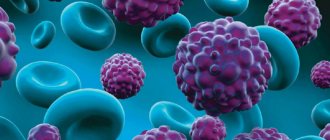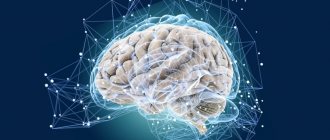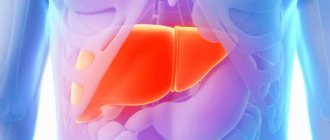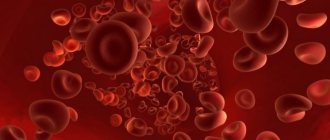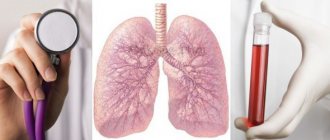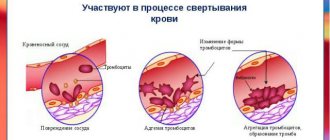Decoding indicators in a biochemical blood test
ALT (full name “alanine aminotransferase”) is an enzyme, mainly found in the tissues of the liver and kidneys , with the help of which the amino acid alanine is exchanged, immunity is increased, and lymphocytes are intensively produced. ALT.
Like ALT, AST or aspartate aminotransferase is an intracellular enzyme. AST is involved in the transfer of amino acids aspartate. This is a building protein that is responsible for the synthesis of amino acids. AST is concentrated in greatest quantities in the tissues of the heart, kidneys, muscle and nerve tissues. The activity of aminotransferases is accelerated by vitamin B6.
During normal functioning of the body, aminotransferases practically do not enter the blood. An increase in indicators occurs when the integrity of cells is disrupted in large quantities, when enzymes are released.
A high level of the ALT enzyme in a biochemical blood test indicates damage to organ tissue, most often the liver. If the AST level exceeds ALT, we can talk about myocardial damage.
Liver diseases often develop asymptomatically. A biochemical blood test for ALT and AST is designed to promptly identify disturbances in the functioning of internal organs in order to eliminate disturbances at an early stage. It is recommended to donate blood for ALT and AST once every 6 months for preventive purposes.
ALT and other indicators
In order to assess the patient’s condition with maximum accuracy, doctors analyze not only the compliance of each individual indicator with the norms, but also the combination of deviations. In serious diseases, deviations affect most biochemical parameters.
Together with ALT, the importance of another enzyme, AST, is considered. It is also present in the cells of parenchymal organs, but the bulk is concentrated in the heart muscle.
In healthy people, AST levels exceed ALT by approximately 1.5 times. In the opposite situation, metabolic disorders can be suspected when proteins are consumed to obtain energy, and carbohydrates are stored as reserves.
The de Ritis index is considered important for diagnosis. This is the ratio of AST and ALT. Its norm is 1.33, a deviation of 0.4 units upward or downward is allowed. A significant increase in the index is observed with myocardial damage (more than 2). The index approaches 2 with chronic alcoholic liver damage. Pathologies of the hepatobiliary tract provoke a significant decrease in the indicator. In most cases, elevated ALT is accompanied by an increase in bilirubin concentration.
To detect liver diseases, it is important to evaluate several enzymes (ALT, AST, alkaline phosphatase, gammaglutamyl transpeptidase) and the degree of their abnormalities. The larger they are, the more intense the pathological process and the higher the threat to the health and life of the patient.
Table - Deviation of enzyme levels
| Index | Norm | Easy degree of enhancement | Average | Heavy |
| ALT | 3‒33 | 2-3 times more | 10 times | 20 times or more |
| AST | 11‒35 | |||
| Gamma GT | 2‒63 | |||
| alkaline phosphate | 36‒106 | 1.5–2 times more | 5 times | 5 times or more |
Mild and moderate disturbances are observed in non-alcoholic fatty liver disease, chronic viral hepatitis, as well as in the initial stages of the development of tumor diseases. An average increase accompanies chronic inflammatory lesions of the gland and ethanol poisoning. A significant increase in indicators is observed in acute forms of hepatitis, toxic damage, as well as in the later stages of cancer or cirrhosis.
Blood levels in men, women and children
The normal level of ALT and AST differs by gender and children of different ages. A slight deviation from the norm of aminotransferases can be a consequence of nutrition, physical activity, lifestyle, long-term use of certain drugs and is not a cause for concern.
| Enzyme | AST | ALT |
| In men | Up to 47 units/l | Up to 45 units/l |
| Among women | Up to 35 units/l | Up to 31 units/l |
| In children under one year old | Up to 60 units/l | 54 - 56 units/l |
| In children under 3 years of age | 40 - 45 units/l | 33 units/l |
| In children under 6 years of age | 29 units/l | |
| In children under 12 years of age | Up to 39 units/l |
Patients are often concerned if ALT and AST are elevated. What this means is determined by how many times the result differs from the norm. Pathologies are indicated by indicators several times higher than normal. A slight increase occurs with types of viral hepatitis and fatty liver hepatosis. Up to 20 times in case of inflammatory processes of the liver, cirrhosis.
When the level increases more than 20 times, liver destruction is observed. In severe liver conditions, ALT reaches a critical level; in myocardial infarction, AST reaches a critical level.
Hepatitis is usually diagnosed when the amount of bilirubin is elevated. In adolescents, changes in ALT and AST levels during growth are considered normal. Exceeding the norm in infancy is also not a pathology.
How to lower AST in the blood?
People who are looking for an answer to a similar question need to clearly understand: an increase in AST is not an independent disease and therefore there are no separate measures to reduce it!
Since this sign signals the destruction of cells containing this enzyme (heart, liver, muscles), it is necessary to diagnose and treat diseases of these organs. Only healthy tissues will be able to function normally and bring all indicators of a biochemical blood test, including AST, back to normal.
It is necessary to clearly understand that an increase in AST is not the cause of the disease. This is its consequence. Therefore, only the elimination of the causative disease can interrupt the cause-and-effect relationship, which will be reflected in the normalization of AST activity and will become a criterion for victory over this disease. Any cases of increased aspartate aminotransferase are a reason to seek specialized medical help. This harmless and asymptomatic sign often hides serious chronic diseases that will only manifest themselves after some time.
Author of the article:
Mochalov Pavel Alexandrovich |
Doctor of Medical Sciences therapist Education: Moscow Medical Institute named after. I. M. Sechenov, specialty - “General Medicine” in 1991, in 1993 “Occupational diseases”, in 1996 “Therapy”. Our authors
Reasons for increased ALT in adults
Since the content of enzymes in organs varies, the ratio between ALT and AST, which is called the Ritis coefficient, helps to narrow down the range of possible diseases.
An increase in ALT is mainly caused by problems with the liver or the ingestion of substances that affect its functioning:
- Drinking alcoholic beverages before taking the test.
- The use of certain medications: antibiotics, antifungals, hypoglycemic drugs, anticonvulsants.
- Drug use.
- Taking herbal preparations.
- Unhealthy eating.
- Exposure to stressful situations and heavy workloads.
- Surgery shortly before the study.
- The presence of malignant tumors in the liver.
- Chemotherapy and its consequences up to 3 months.
- Lead poisoning.
- Viral hepatitis.
- Toxic hepatitis caused by self-medication, the use of dietary supplements and herbal preparations.
- Aggravated form of pancreatitis.
- Inflammatory myocardial damage.
- Myocardial infarction.
- Obstruction of the bile ducts and their compression.
- Cholestasis.
- Hemochromatosis is a hereditary liver disease.
- Cirrhosis of the liver.
- Muscle dystrophy.
Causes of increased enzymes in the blood
The level of the amount of these substances in the blood is affected by the general condition of the body and the presence of any infectious diseases in it. For example, such ailments as hepatitis, pancreatitis, heart attack.
Various liver diseases, for example, heartburn, cirrhosis, cancer, as well as hepatitis of various natures, lead to the destruction of many healthy cells of the body, especially the diseased organ. This leads to the fact that ALT from destroyed cells enters the blood and its value during analysis increases significantly. The more of this enzyme in the blood, the more serious the stage of development of the disease. Often, along with this substance, the presence of diseases is indicated by an increase in bilirubin levels .
A heart attack can also cause an increase in these indicators. Since during this disease some areas of the heart muscle simply die, a lot of both ALT and AST enzymes are released into the blood. Any diseases that contribute to the processes of heart destruction contribute to the same phenomenon.
Acute pancreatitis In general, any injury that results in widespread muscle destruction and trauma, such as severe burns, is also accompanied by an increase in transaminases.
Reasons for increased AST in adults
An excess of AST levels over ALT is most common in heart diseases:
- Acute myocardial infarction. The odds increase after 2-3 days.
- Heart injuries.
- Myocarditis.
- Destruction of heart tissue.
- Myositis is inflammation of the muscles.
- Hepatitis of various types.
ALT and AST levels are elevated in various types of hepatitis.
- Liver damage from toxic substances.
- The presence of malignant liver tumors.
- Metastases.
- Partial cirrhosis of the liver.
- Liver damage caused by prolonged alcohol consumption or heavy drinking.
- Extensive damage to muscle tissue.
- Impaired blood flow to the liver.
- Damage to the intestinal mucosa.
- Wilson-Konovalov disease is a hereditary disorder of copper metabolism.
- Hyperthyroidism is a hormonal disease characterized by increased thyroid function.
- Cholestasis.
- Long-term compression syndrome, mechanical damage.
- Obesity.
Reasons for the increase in indicators
Alanine aminotransferase is elevated in many diseases in the body. Most often, an excess of the indicator occurs due to liver pathologies. Less commonly – diseases in cardiology.
In 10% of cases, a high ALT value indicates damage to the pancreas, as well as injuries to internal organs.
Reasons for increased alanine aminotransferase levels:
- Hepatitis. Nerve endings are located only in the organ capsule, so damage to the parenchyma is not accompanied by symptoms. Signs appear after the necessary changes appear in the liver.
- Cirrhosis. With prolonged exposure to toxic substances or infectious damage to the liver, inflammation develops. Due to a protective reaction, organ tissues degenerate.
- Steatosis. The disease is characterized by fatty degeneration of the liver. That is, the cells are replaced by adipose tissue, so the ALT value increases.
- Chronic alcoholism. When alcohol affects the liver, an inflammatory process develops. Gradually, the organ is destroyed, resulting in an increased likelihood of cirrhosis.
- Cholestesis . Stagnation of bile occurs not only in the bladder, but also in the ducts. As a result, an increase in ALT levels is possible.
- Neoplasm. As a result, healthy organ tissues are damaged. An increased value of alanine aminotransferase is observed with a malignant tumor in the liver. But there may be neoplasms in other organs - the pancreas, lungs.
- Myocardial infarction. The more necrosis, the higher the ALT level. A heart attack occurs due to impaired blood flow. If the pathology proceeds without complications, the ALT level increases gradually.
- Chronic heart failure.
- Myocarditis. The disease appears in the affected heart muscle. The result is shortness of breath, fatigue, and increased ALT levels.
- Mononucleosis. The disease is infectious. As a result, the composition of the blood changes, damage appears in the liver and spleen.
- Acute pancreatitis.
An increased ALT value in a pregnant woman is not always considered a deviation, and also does not indicate pathology in the fetus. This happens due to the fact that the uterus puts pressure on nearby organs - the liver. As a result, slight tissue damage occurs and the release of ALT into the blood increases.
Reasons for high rates in childhood
ALT and AST are elevated: what this means in children depends on age and hormonal processes. Before the examination, the child is examined and any complaints are taken into account.
Elevated enzyme levels in a child’s analysis primarily indicate:
- various liver injuries;
- chronic or acute viral form of hepatitis;
- congenital pathologies of the biliary tract or liver;
- metabolic disease;
- liver hypoxia;
- celiac disease – damage to the mucous membrane of the small intestine;
- liver damage from toxic substances or medications;
- the presence of viral diseases;
- blood diseases;
- low potassium content;
- thrombosis;
- mononucleosis;
- pathological conditions of the heart;
- heart disease;
- obstruction of the biliary tract;
- muscular dystrophy;
- polymyositis;
- pituitary diseases;
- the presence of malignant tumors;
- kidney infarction;
- consequences of heart surgery.
Decoding tests for a child differs from deciphering them for adults.
Getting to know ALT
The substance is produced at the cellular level; it enters the blood in small doses. Therefore, a rapid increase in the indicator indicates the onset of pathological changes. As a result of the development of the disease, increased production of alt begins.
The enzyme takes part in the process of amino acid metabolism and this is its main function. It serves as a catalyst in the transfer of alanine to alpha-ketoglutarate. The need for alanine is due to the fact that under the influence of biochemical processes it is converted into glucose. It directly affects the activity of the brain, promotes the accumulation of energy, and normalizes the function of the central nervous system. Besides this, alt:
- affects the immune system;
- participates in the synthesis of lymphocytes;
- is a regulator of acid metabolism.
In the male population, the process of producing alt occurs faster than in women. The enzyme concentration in the former is higher.
List of organs containing alt for level reduction:
- the liver contains the largest amount;
- the kidneys have less of the substance;
- muscle;
- spleen;
- pancreas;
- red blood cells;
- lungs;
- heart.
What does high level mean in pregnant women?
During pregnancy, changes occur in a woman's body, which can result in changes in test results. This is primarily due to changes in hormonal levels. Slight increases in the level of coefficients in the blood at the beginning of pregnancy or in the 3rd trimester are not a pathology.
If the indicators do not normalize over time, we can talk about heart disease, liver disease or disruption of their functioning. Liver function can be disrupted by compression caused by fetal growth. Pressure on the organs also leads to stagnation of bile, which increases ALT and AST levels.
Pregnancy can cause exacerbation of chronic diseases. It is necessary to pay attention to the woman’s condition. If you experience shortness of breath, weakness, changes in skin color or abdominal pain, you should immediately get tested and determine the cause of the illness.
The appearance of severe injuries and burns also provokes an increase in the level of enzymes in the blood.
In addition to serious conditions, the indicators are affected by the use of certain medications. In the absence of obvious reasons, elevated ALT and AST indicate that the load on the woman’s body is too great. In this case, it is necessary to perform an urgent birth. If the condition is stable, the pregnant woman is observed in the hospital.
What can you find out when determining the level of aspartate aminotransferase in the blood?
If AST in the blood is slightly increased (about 5 times), then this may be due to fatty hepatosis, taking certain medications (barbiturates, statins, antibiotics, drugs, chemotherapy drugs, etc.).
A moderate, average increase in the enzyme (up to ten times higher than normal) can be caused by chronic liver diseases, cirrhosis, myocardial infarction, myocardiostrophy, processes occurring with damage to kidney and lung cells, mononucleosis, cancer.
If AST in the blood is greatly increased (10 times or more), this tells the doctor that the patient may have viral hepatitis in the acute stage, toxic damage to the liver structures, drug-induced hepatitis (acute), and this may also indicate a disease in the body processes accompanied by tissue necrosis (for example, with tumors).
At the beginning of the disease, in its acute stage, when the process of tissue destruction is fastest, the highest level of aspartate aminotransferase is observed. A decrease in AST in the blood serum means the beginning of restoration processes in organ cells and the patient’s recovery. Slight excesses of the norm are not a sign of tissue destruction.
How serious is the decrease in ALT and AST activity?
Any change in the level of ALT and AST indicates disturbances in the body. A decrease in indicators is possible with severe liver damage, cirrhosis, extensive necrosis, cancer, genitourinary infections, and vitamin B6 deficiency. The lack of vitamin is especially acute in pregnant women.
Each individual case should be reviewed by a doctor, as self-medication will lead to a worsening of the condition. A decrease in ALT and AST during necrosis indicates a decrease in the number of healthy cells and is a dangerous condition for health. Vitamin B6 deficiency can be compensated for by food: nuts, legumes, cereals, dairy products, meat, fish.
Pregnancy and increased ast and alt
An increase in AST and ALT with normal bilirubin occurs in the first three months of pregnancy and reaches 31 units/l. This figure is considered normal for this period. With the correct course of pregnancy, this level remains for the entire period, until the birth of the child.
In the later stages of gestation, gestosis may develop. Women experience weakness, nausea, and dizziness. Possible increase in pressure. The higher the level of ast and alt with normal bilirubin, the worse the woman endures the last trimester of pregnancy.
Indications for testing: symptoms
A biochemical blood test for ALT and AST is mainly prescribed when a pathological condition is suspected. The presence of symptoms indicates the severity of the disease.
Since increased levels of aminotransferases are primarily associated with liver and heart diseases, the most common symptoms of pathologies are as follows:
- abdominal pain;
- heaviness in the right hypochondrium;
- yellowing of the skin, whites of the eyes, mucous membranes;
- prolonged weakness, increased fatigue - signs of myocarditis;
- conditions caused by intoxication;
- causeless nausea and vomiting;
- weak appetite;
- dysfunction of the gastrointestinal tract: diarrhea, flatulence, belching;
- change in color of stool;
- itching;
- dyspnea;
- pain in the heart area;
- pain in the limbs;
- bleeding.
In other cases, elevated ALT and AST mean that the integrity of the bone or muscle is compromised. These conditions may be overt or asymptomatic, but recent injuries suggest that rates will be increased.
Monitoring the level of ALT and AST is carried out as a preventive measure in patients with diabetes mellitus, overweight and a predisposition to liver diseases, during pregnancy. The analysis is also prescribed as a way to monitor treatment with drugs that affect the liver.
What is AST
Aspartate aminotransferase (AST, AST ) - is designed in the body to speed up chemical reactions. This enzyme is found inside the cells that make up the liver and heart, but is also present in red blood cells (erythrocytes), muscle tissue, the pancreas and the kidneys. AST can be found in very small amounts in the blood outside of cells. [, , ]
AST is very similar to ALT (alanine transaminase), because both of these enzymes are contained in the cells of the liver parenchyma. The only difference is that ALT is mainly found in the liver, while AST is also present in the cells of other tissues of the body. Therefore, ALT is thought to be more specific for detecting inflammation in the liver, while AST may indicate disease not only of the liver, but also of heart disease, acute pancreatitis, hemolytic anemia, severe burns, kidney disease, musculoskeletal disease, or trauma ( wounds). [, ]
AST speeds up a chemical reaction in cells that is necessary for metabolism . This chemical reaction occurs primarily in the liver , where one of the end products of this metabolism, glutamate, is redirected to the kidneys to be excreted in the urine. []
LOCATION OF AST AND ALT ENZYME IN THE HEPATOCYTE (CELL) OF THE LIVER
How to prepare for testing for ALT and AST
To carry out the analysis, blood is taken from a vein. ALT and AST indicators are subject to third-party influence.
To ensure that the result of the biochemical analysis is not affected by external factors, the patient must follow the recommendations for preparing for the procedure:
- The study is carried out in the morning.
- Before the analysis, it is forbidden to eat food for 8-10 hours; you are allowed to drink still water.
- It is necessary to refrain from alcoholic beverages, smoking and taking medications at least a week before the procedure. If it is impossible to stop taking medications, you should inform your doctor.
- To avoid microtrauma to muscle tissue, it is recommended to limit physical activity 2–3 days before the analysis.
- Limit the amount of fermented milk products.
- Do not eat fatty foods. You don't need to completely change your diet.
- Do not smoke before the test.
- You need to arrive early, don't rush. It is recommended to sit quietly for 10 minutes before the procedure.
- Protect yourself from stressful conditions, do not be nervous before the analysis.
- Do not undergo X-ray examinations the day before the procedure.
Possible consequences of elevated enzymes
An increase in ALT and AST levels, even a slight one, already indicates the development of the disease; if you do not look for the cause, do not take any treatment measures and eat your favorite fatty, salty and spicy foods, drinking alcohol, you can provoke irreparable consequences:
- Fatty hepatosis;
- Hepatitis;
- Cirrhosis of the liver;
- Heart failure;
- Myocardial infarction;
- Acute pancreatitis.
Oddly enough, all these terrible diseases, which subsequently provoke premature death, can be well cured in the early stages of their development.
Because men more often do not give importance to their health, hoping that it will go away on its own or that they simply cannot have it, their life expectancy is much shorter than that of women. A person is given one health and he needs to take care of it; he should not be afraid of doctors, and at the first signs of problems in the body, he should seek medical help.
What to do if the readings are elevated
The test results are ready, ALT and AST are elevated. What does this mean, is the condition dangerous and what sequence of actions will the doctor who dealt with the decoding tell you? To determine an effective way to normalize enzyme levels, you first need to identify the cause of the condition.
To do this, the doctor prescribes additional studies of the liver, heart and other organs:
- tests for various types of viral hepatitis;
- tests for autoimmune types of hepatitis;
- Wilson's disease test;
- iron content for hemochromatosis;
- liver biopsy;
- repeat blood test;
- computed tomography, ultrasound, ECG.
In addition to further examination, measures should be taken to avoid aggravating the condition:
- give up alcohol;
- balance nutrition;
- avoid radioactive radiation;
- spend more time in an environmentally friendly environment.
Depending on the severity of the disease, hospitalization or monitoring of the condition is carried out.
What does ALT, AST mean in a blood test?
ALT is an enzymatic alanine aminotransferase produced in the cells of the liver, heart, kidneys, muscles, and pancreas.
AST is an aspartate aminotransferase located in the heart, muscles, liver, nerves, lungs, kidneys, and pancreas.
If an adult or child suffers damage to the organs in which enzymes are concentrated, they are released and their concentration in the blood increases. The substance is detected in a biochemical test. Most aminotransferases are localized in the liver.
There they perform the following functions:
- peptide production;
- isolation of biochemical components;
- removing toxins and harmful substances from the body;
- accumulation of glycogen necessary for energy synthesis in tissues;
- regulation of the synthesis of microparticles involved in biochemical reactions.
Transaminase normal levels depend on gender. Women have a greater value compared to men. An increase in the level of the substance was detected in children. The maximum concentration is observed in the first 5 days after birth.
Laboratories have various equipment that detects the indicator. Depending on the quality of the equipment, the accuracy of the data obtained is determined.
Treatment with medications
If ALT and AST levels change, drug treatment of the symptoms of the disease is possible. However, self-medication will worsen the condition; you can only take medications prescribed by your doctor.
- For autoimmune hepatitis, Duphalac and antiviral drugs are prescribed.
- When changes in enzyme levels are associated with liver disease, Hepatoprotectors are prescribed - medications that help restore the structure of liver cells. Enzyme preparations eliminate inflammation.
- Magnesium is prescribed to maintain normal functioning of the heart muscle.
- If a muscle ruptures, your doctor may recommend medications that accelerate protein synthesis and cell regeneration. Calcium supplements help restore bone integrity.
- To strengthen the immune system, it is possible to use anti-inflammatory medications or interferons. Once the infectious process is suppressed, cell restoration begins.
- Acute attacks of pain are suppressed with analgesics.
In addition to medications, you can ask your doctor about herbal supplements that stimulate liver function.
Why does ALT increase in men?
Men more often violate all the rules of proper nutrition and experience stress and nervous strain much more actively, which they try to overcome with the help of bad habits. This will cause liver diseases and will naturally increase ALT levels.
Elevated ALT in the blood of men is detected when:
- Taking certain medications;
- Abuse of fast food, which is sold in any eatery;
- Muscle injuries;
- Alcohol abuse;
- Violation of blood sampling rules;
- Stress and nervous overload;
- Physical activity associated with sports or hard work;
- Testing after any surgical intervention;
- A large accumulation of fat cells in the liver area or simple obesity;
- Malignant tumors;
- Chemotherapy or radiation therapy;
- Lead poisoning;
- Taking drugs;
- Psychological shock.
Table ALT norm by age:
Folk remedies to lower the level of indicators
The changes are minor, but ALT and AST are still increased. What this means in a particular case will be revealed by additional research. Treatment with folk remedies should not replace medications and medical supervision.
However, there are decoctions and infusions, the use of which, with a slight increase, normalizes the functioning of internal organs and lowers the level of aminotransferases:
- Herbal infusion for liver pathologies. Mix and grind 20 g of celandine, 40 g of immortelle, 40 g of St. John's wort. Pour into a thermos, add 1.5 liters. water brought to a boil. Ready for use after 12 hours. Drink 4 times a day for 2 weeks. The infusion promotes the regeneration of liver cells.
- Infusion for heart disease. For a glass of boiling water 1 tsp. adonis. Leave in a warm place for 2 hours. Take 1 tbsp on an empty stomach. l. several spoons a day for 2 weeks.
- Dandelion infusion. In a container of 0.5 l. Place flowers, pour 150 ml. vodka. Take 2 tbsp every 24 hours. l. 3 times. Duration of treatment is 2 – 3 weeks.
- Milk thistle infusion. Grind the seeds, brew 1 tsp. for 250 ml. Leave in a warm place for 20 minutes. Strain. Drink 3 weeks 2 times a day 30 minutes before meals. Drink the decoction slowly. Indications: hepatitis, liver disease.
- Corn decoction. Dry and grind the corn hairs. 1 tsp. 200 ml. boiling water Let it brew for 15 minutes. Take 1 glass 2 times a day for 3 weeks.
Norms by age
Among women
The ALT norm in women should be in the range of 10-35 U/liter of blood and increases over the years. Changes by age are presented in the table:
| Age (years) | ALT value in units per liter |
| 18-25 | 10-33 |
| 25-40 | 10-34 |
| 40-50 | 10-35 |
| 50 and older | 10-35 |
In men
The ALT norm in men is 8-38 U/l. Unlike women, the rate decreases with age.
| Age | Acceptable value in U/l |
| 18-25 | 10-35 |
| 25-40 | 10-40 |
| 40-50 | 10-39 |
| After 50 years | 8-38 |
During pregnancy
| Trimester | Indicator in units/liter of blood |
| I | Up to 32 |
| II | 31 |
| III | 30-31 |
In fact, small individual deviations and errors are possible.
Features of nutrition at high ratios
Proper nutrition is an extremely important part of treatment.
The following rules must be observed:
- The diet should primarily consist of plant foods that are high in nutrients. This will cleanse the liver of toxins and speed up cell recovery.
- Drink jelly for breakfast.
- Eat fresh vegetables and fruits of different colors.
- Diversify your diet with lean meat and fish. High fat content makes it difficult for the liver to function.
- Limit the amount of salt in food. Salt retains fluid in the body and causes swelling.
- Follow a diet: do not overeat and do not starve.
- Eat freshly prepared food.
- Chew thoroughly.
- Enrich your diet with proteins: cereals, eggs, dairy products.
- Avoid fried foods cooked in oil.
- Limit consumption of processed foods: canned food, sausages.
- Limit consumption of carbonated drinks.
- Do not include foods high in salt in your diet.
- Avoid alcoholic drinks. Alcohol contains toxins that cause liver damage when filtered.
- Maintain water balance: drink clean water without carbon, green tea.
- Have a light dinner at least 2 hours before bedtime.
- Pay great attention to vitamin B6. It is found in soybeans, bananas, walnuts, spinach, avocados, and liver.
- Consume more vitamin D. The vitamin protects the liver from damage and normalizes its functions. Natural sources - apples, leafy vegetables, dairy products, zucchini, mushrooms, oysters, cod liver. A fruit or vegetable per day is enough to get your daily dose of the vitamin.
In addition to changes in diet, it is also necessary to adhere to a healthy lifestyle. Stop smoking and avoid passive intoxication. It is necessary to adhere to a daily routine and spend as much time as possible in the fresh air. Moderate physical activity will strengthen the body.
In order to exclude the possibility of inflammatory processes, it is recommended to have a permanent sexual partner.
Abnormal blood test results often force you to reconsider your diet and lifestyle. To stay healthy, you should check your ALT and AST periodically. This does not mean that it is necessary to take action only when enzyme levels increase. It is not necessary to wait until the body indicates the development of pathologies. You can start taking care of yourself now.
Evaluation of the values in the protocol, their decoding and normal level
When a blood test protocol is received, its decoding makes it possible to see the usual indicators of alt and ast. Usually transaminases are characteristic in their combination. Such indicators more clearly indicate the nature of pathological processes in the body.
Sometimes a special de Ritis index is used, which helps to accurately assess the level of the alt-to-ast ratio. In healthy people, it is usually equal to 1.3. In the presence of liver diseases, it decreases, and in cardiac diseases it increases. Moreover, the second indicator grows slightly, and the first – very sharply.
As a rule, the level of liver enzymes in the blood of women is slightly lower than that of the stronger sex. This imbalance is explained by lower body weight and more modest muscle volume. Such characteristics in this case do not have such an increased effect on the liver as occurs in men.
The unit for assessing the level of transaminases is a variety of units, which are taken as the basis for calculations by each individual laboratory.
The usual numbers for healthy women are normally as follows:
ALT:
- 7-40 IU/l (for men – up to 45);
- 28-190 mmol/l;
- up to 33 U/l.
AST:
- 10-30 IU/l (in men – up to 47);
- 28-125 mmol/l;
- up to 32 U/l.
As can be seen from the data, high levels of alt and ast in the blood test of the stronger sex are natural. It is due to more intense muscle work and high speed of cell division processes.
Excess transaminase levels in women
If, when deciphering the analysis, it is clear that ast and alt are elevated, then their values indicate a threat of pathology development. Most often, such changes occur due to various liver diseases of infectious and non-infectious origin.
In case of autoimmune disorders of the organ, transaminases are also the first to react. With pancreatitis and other pathologies of the pancreas, liver enzymes always increase sharply, which is associated with a change in the synthesis of amino acids.
When a biochemical blood test is performed for suspected myocardial infarction, it is very important to evaluate what the alt and ast indicators indicate. Damage to muscle fibers in such a disease causes a significant release of transaminases, which is instantly detected by analyzers
In general, with cardiac diseases of various etiologies, liver enzymes always increase. This is due to the fact that the smooth and striated muscles of the heart are not capable of rapid recovery, as a result of which the products of cellular decay enter the bloodstream.
In case of extensive injuries with muscle rupture, burns or wounds, alt and ast in large quantities are also recorded during a biochemical blood test.
To make an accurate differential diagnosis, additional research is required, as well as data from a visual examination of the patient.
Need to:
- listen to his complaints;
- identify the presence of pain;
- check the degree of general well-being of the patient;
- evaluate the color of his skin and sclera;
- measure blood pressure;
- do an ECG;
- conduct a general urine test.
Thus, the conclusion follows that when conducting a biochemical blood test, the norm of alt and ast in men and women differs quite significantly. Moreover, the indicators among representatives of the stronger sex are higher.
